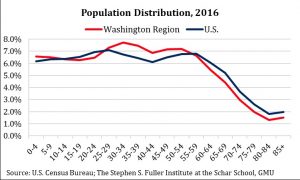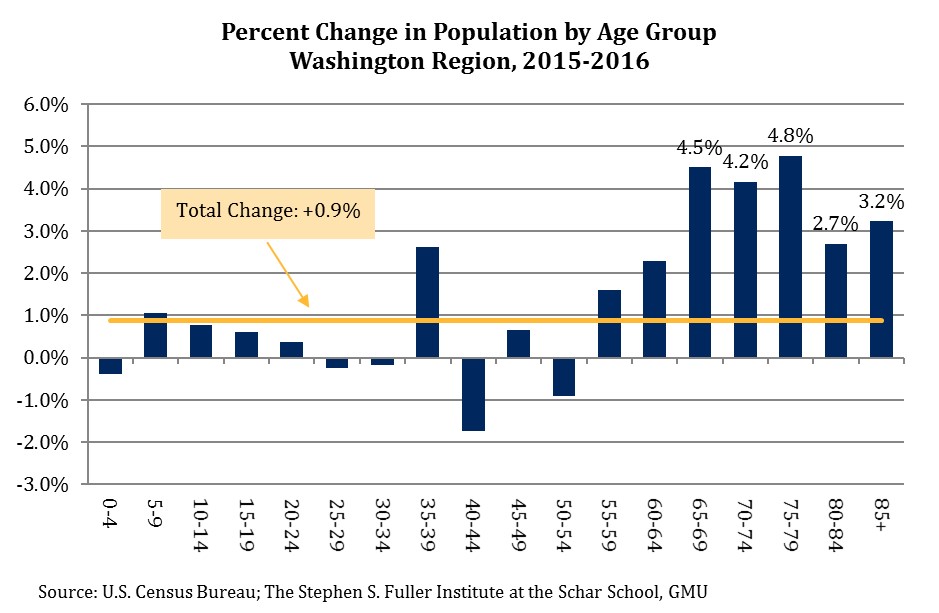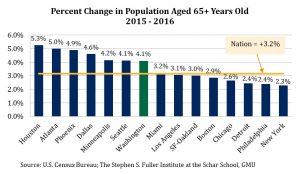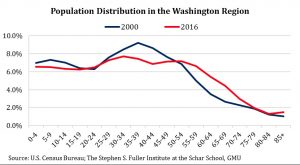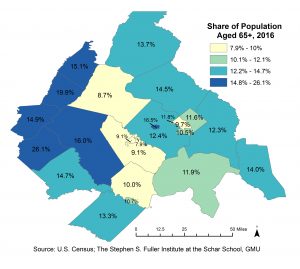From The Washington Business Journal:
Greater Washington is getting older — and it’s aging faster than the country as a whole.
In 2016, 12.2 percent of the region’s population was over 65 years old, up from just 9 percent in 2000, thanks to the continued growth (and aging) of older residents. And in 2016, when the region’s population increased by 53,508, the biggest growth came from an 11,705 increase in people ages 65 to 69 (the region actually lost about 2,000 people aged 25 to 34), according to data from the Stephen S. Fuller Institute at George Mason University.
That meant a 4.1 percent increase in Greater Washington’s 65-and-older population between 2015 and 2016, compared with a national average of 3.2 percent.
The aging of the region is the flip side to Greater Washington’s inability to attract and retain younger people, who are more able to leave for new jobs and opportunities elsewhere. Meanwhile, the large and aging baby boomer generation is here to stay.
So what’s going on exactly?
- The region is still young, thanks to the growth in millennials during and immediately following the Great Recession. But the growth in older residents outpaces the nation as a whole, and in time will erase the edge the D.C. region has gained in having a younger workforce.
- In 2016 in the Washington region, the fastest growing age groups were all older adults. Altogether, the number of adults aged 65 and up grew 4.1 percent between 2015 and 2016, compared to just 0.4 percent for people under 65 years old.
- The faster growth in older residents puts D.C. in the middle of the pack of the 15 largest metro areas, placing it at No. 7 in the growth of older residents, nearly tied with Seattle and right ahead of Miami. New York’s older population grew just 2.3 percent.
And that aging population in Greater Washington, just like elsewhere, is having an effect on the local economy.
“Some of the job growth we have seen recently is tied to the aging of the population. The increase in the education and health sector is mostly tied to health care, where the job growth we have been seeing lately is mostly home health care aides,” said Jeannette Chapman, deputy director and senior research associate at the Fuller Institute. “That is a little bit different than what people think of when they think of job growth.”
The baby boomer generation is also increasingly retiring, which will create problems down the road for employers looking to fill jobs among a smaller pool of younger workers — although the region is still a long ways away from that happening, Chapman said. But for years D.C. has had the ability to attract young workers and keep them throughout their career, a feature that may not be as prevalent in the future.
Right now data show just the beginning of a trend, and Greater Washington is still ahead of many other metro areas when it comes to the growth of its older populations. But the signs of workforce aging far more rapidly than the national average are there, too.
“It’s happening here. It’s happening elsewhere at faster rates but that doesn’t mean we can ignore it,” Chapman said.
View the full story ›
Copyright Washington Business Journal, reprinted with permission
Graphics from the story:
